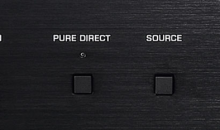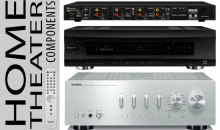Top 10 Mistakes When Hooking Up a Home Theater System
I’ve seen lots of errors in my time as more and more of friends, family and clients start hooking up a home theater system. These mistakes can range from simple problematic issues to things that could quickly lead to premature device failure. In no particular order, here are my top ten mistakes when hooking up a home theater system:
10. Use the Right Speaker Cables
You don’t have to buy expensive cables to run wire for those surround sound speakers, but you had better not think that some left over 24 gauge cable is sufficient to make that 50 foot run from your AV receiver to your surround speakers.
Let me quickly explain why. Every cable has inherent resistance. Since we’re talking about resistance to the flow of electricity, it feels a little backward. The thinner the cable, the more resistance the cable will have. There are other factors as well, but this is the big one. The more resistance a cable has, the more it will affect the frequency response which is possible at the end of the cable run. The reason this is related is that the load the amplifier has to deal with when driving a pair of speakers, changes with frequency. So if you add more resistance with cables that are too thin, you can actually change the sound—particularly at higher frequencies.
A good rule of thumb when hooking up a home theater system is that 16 gauge cable will work in just about any in-room situation, but if your runs are going to be over 40-50 feet in length, 12 gauge cable will further drop your resistance and keep your cables from becoming equalizers for your sound. If you’re running cables further than 50-60 feet you may want to rethink your multi-zone audio system design.
9. Don’t Overbuy on Your Interconnects
I see it all the time. People buy the most expensive cables at the last second because they didn’t include them at the time they ordered their speakers. Interconnect cables are important—in that your system won’t work without them. But having 24 karat, gold-plated RCA cables or battery-powered HDMI cables simply isn’t going to make your system sound any better. When you’re merely connecting a DISH satellite box to your AV receiver—a grand total of a three-foot run—you’re just not going to run into issues if the cable is at least made well. There’s not enough distance to have any problems or lose frequency response. The same goes for digital HDMI cables. Distances over 10 feet are where the problems lie. Plan ahead and keep it simple and you’ll avoid overspending.
8. Pay Attention the the HDMI Features of Your Cable
Thanks to the geniuses at HDMI Licensing (I am being facetious), the “any-old HDMI cable will do” mentality has gone out the window. Back when HDMI only handled 1080p video plus audio you could pretty much grab any cable up to 20 feet in length and it would work. Now you have features like integrated Ethernet and 4K support. If you’re planning ahead, you want to make sure the HDMI cables you buy now are going to last you when the “next big thing” happens. This is especially true if you plan to run your cables in the wall or crawl space and they can’t easily be replaced or upgraded. Pay attention to the labeling on HDMI cables and you’ll likely save yourself a headache later on. As a good baseline, always buy “High Speed” HDMI cables as they tend to have the latest design that supports most of the latest features.
If you don’t know what’s available in HDMI, here are the basic features:
- HDMI Ethernet Channel
This is a data channel added to the original HDMI connection that enables high-speed, bi-directional communication. Connected devices that include this feature can send and receive data via 100 Mb/sec Ethernet, so Internet-enabled HDMI devices can share an Internet connection via the HDMI link, with no need for a separate Ethernet cable. It also provides the connection platform that will allow HDMI-enabled components to share content between devices. - Audio Return Channel
This is an actual audio channel that lets a TV send audio from either a built-in tuner or DVD player upstream to the A/V receiver via the HDMI cable. There’s now no need for an extra cable (or AV receiver input connection). - 3D
New 3D gaming and movie formats and resolutions for HDMI-enabled devices require the cabling to handle 3D resolutions up to dual-stream 1080p. - 4K Resolution Support
These new extremely high HD resolutions are more or less four times the resolution of a standard 1080p signal. These cables are rated to handle the full 4K resolution over HDMI.
Of course the trick with HDMI cables is that certification doesn’t necessarily imply that all cable lengths were tested. It’s supposed to mean that, but we see too many instances where longer cables are on the market, and they just don’t do the job. Which brings us to…
7. Active HDMI Cables are Best for Future-Proofing Your System and Going the Distance
Newer active HDMI cables actually have a chip embedded in them which is powered by the 5V available on the HDMI connector itself. These “smart” cables correct for what happens to the digital signal over long distances. Remember, HDMI is capable of sending billions of bits of data at any given second. That’s a LOT of data and it can get screwed up pretty easily. When it drifts out of whack far enough, you no longer get an image. Active HDMI cables solve that problem (for the most part) and give you a clean signal at distances previously unknown to the format. In addition, the chipsets embedded in these cables are getting less expensive to manufacture, and so active cable prices continue to drop. If you want to run a cable for 25 feet or less, a standard high-speed cable will work for you at 1080p. If, however, you want to run a cable longer than 15 feet and 4K is on your horizon, you should probably be looking at an active HDMI cable.
6. Speaker Phase Matters!
Tower speakers and bookshelf speakers must be connected in phase. That means the positive lead on the AV receiver or amplifier is ultimately connected to the positive lead on the speaker and so on with the negative leads or terminals. When connected properly, the wave from each speaker is “additive” and all is well—the sound is as you’d expect from a stereo or multi-channel recording.
If just one speaker is wired backwards, however (positive lead to negative terminal, etc) then your system has become subtractive. A subtractive system has little effect on the wider stereo-separated sounds, but those sounds panned in the center may all but disappear. It may sound a bit like the sound is coming from inside your head, or the bass may simply be gone altogether. These two indicators are excellent signs that you may have a wire crossed. For speakers that you can’t get to, a 9V battery can be used to test phase. Simply touch the speaker cable leads briefly to the battery and observe the speaker (you may need a helper). Note that the small terminal on a 9V battery is the positive one and orienting the “positive” speaker lead to that should make the speaker driver push outwards. I have yet to see anyone break a speaker using a 9V battery provided you don’t leave it on there for long. If you touch the leads properly and the speaker driver pulls inward—you’re wiring is backwards. You don’t have to do anything except swap them at the AV receiver or speaker.
5. Heat Rises to the Top!
If you use a rack or shelves for your AV gear, remember to put the amplifier or home theater receiver at the top if possible. Heat rises and so you don’t want the amplifier to be at the bottom where it will contribute to baking all of the other components and have a harder time ventilating. It may seem counterintuitive to have it up top, but it’s a better choice in the long run. This is also related to our next item…
4. Ventilation is Not Optional!
If you are storing your home theater equipment in a piece of furniture, make sure you have adequate ventilation. I went to a home a little while ago where a friend told me he thought his amplifier had stopped working. It took me about 10 seconds to figure out why: He had stored it in a cabinet and frequently ran it with the doors shut! An amplifier generates lots of heat. If you contain that heat in an enclosed space you’ll eventually bake the components and the amplifier will fail. Give your AV equipment plenty of ventilation or consider adding a fan to your rack or furniture to encourage more airflow.
3. A Remote Control IS an AV Device
I can’t tell you how many people connect their home theater systems and then proceed to utilize five or six different remote controls (or more) to get everything up and running. I don’t know about you, but this is not my idea of fun:
- Turn on the projector with the projector remote
- Power up the home theater system with the receiver remote
- Activate your electric drop screen with yet another remote
- Power up your Blu-ray player with its remote
- Grab the receiver remote to change inputs because the last thing you did was watch DISH (it has its own remote as well)
- Pick up the Blu-ray remote control again to fast forward through the stupid commercial that pretends Blu-ray Disc technology is still new and was just invented yesterday by magical sprites who live on clouds and bring high definition to you via mysterious bits of data stored within glistening optical discs….
- Pick up the home theater receiver remote again to adjust the volume (which is always louder on previews that the movie itself).
Are you starting to understand why a universal remote control might be a good idea? If you’ve spent good money on a surround sound system, don’t forget to get a great remote to make it all run smoothly. It’s a purchase you won’t regret.
2. Plan for an Eventual Upgrade
Once you start into surround sound, your going to get the bug, You really are. And when you do you want to be able to upgrade your system hassle-free. That means doing some planning up-front. A lot of times this simply means getting equipment that is upgradable. Most AV receivers and speakers are perfectly upgradable, provided you stay away from Bose systems or anything that has proprietary connections through the subwoofer rather than using a standard AV receiver with speaker level outputs and connectors.
And a lot of times making sure you properly install your surround sound speakers is another big step towards being upgrade-ready. I don’t care if you use in-ceiling, on-wall, in-wall, or stand-mounted surround speakers. If you wire them in properly and with care, you can upgrade them eventually with only a minimal amount of hassle. That may mean leaving yourself a little extra cable in the wall, or using standard speaker binding posts in the wall instead of running the cable through a hole and tying it directly to the speaker. It may mean wiring for Surround Back speakers during construction of a home even when you don’t plan to purchase or use them right away. Planning ahead is a big deal and it can save you tons of time and energy in days to come.
1. Wire It All Up For Goodness Sake!
You aren’t going to enjoy your new AV system unless it’s actually, you know, connected. So why do so many people bring home a 5.1 system only to let the surround speakers or center channel speaker languish unused because they didn’t have time to install them? Get those speakers installed. Mounting a TV on the wall will give you plenty of space for your center channel. (Plus, it makes your TV look cooler!)
There are a myriad of ways to install surround sound speakers. This may involve using crown moulding to hide the wires, or venturing into the attic or crawl space…or even pulling up the edges of your carpet. Whatever your method, get those speakers wired and start enjoying your full surround system, as soon as you can. It’s an incredible experience that will change your perception of movies in the home. Oh, and dragging cables across the floor just isn’t going to cut it. Plus, it won’t win you any points with your significant other (who may just veto that next opportunity to upgrade!)







Good afternoon Clint,
I hope you are able to help me!
I have just installed a BT TV, youview box and utilise the sound via my fairly old Sharp ht-cn400dv home cinema system, all seemed ok, however, now my youview remote control is adjusting the volume on the Sharp system every time I change channels ! I can’t seem to find any help in changing the code of the BT remote if that’s what’s required.
Do you have any ideas?
Many thanks
Phil.
You might want to go through the setup process again on the YouView (I’m actually not too familiar with that system).
Ok will do!
Is it possible that the youview remote has the same code as Sharp system? Although the sharp remote does not affect the youview system!
Hi Clint you sound like the guy that can help me. First off if I use too big of speaker cable, is that bad?
I was switching rca’s from one receiver to the next and I did not turn the receiver of or stop the music from playing. I now only have sound from the right side, could I have damaged something?
Thank You
I am currently remodeling my basement/man cave and will be installing 3 TV’s and 3 sets of surround sounds. Since for some reason my upstairs TVs are not in sinc with each other, I was planning on using only 1 receiver for my basement, switchable to use all sound system speakers or only 1, depending on if its a Superbowl party or just a 1 TV family movie night. My question is wiring it all up. I was going to use solid 12 gauge household electrical wire for the speakers, coaxial cable from DirectTV satellite to the receiver, then HDMI to all the TVs. My biggest question is, I will center my 1 receiver in the center of the basement, but by the time I go up the wall across the ceiling and down the wall to the TVs, I’m looking at approx 50 feet of HDMI to EACH TV!!! Can you help out, any advice is appreciated!!
I don’t have an amp. My dad gave me large speakers that I thought I could hook up to my tv rca audio out with a modified speaker wire to RCA. But do I need an amp in between? I admit to being a complete noob.
Hi, I love all this info! Thanks. We ” the people” need it. How would you identify which speaker wire goes to what speaker? If you lost a wire Label? Thanks
Use a 9vdc battery. I expect it isn’t critical, but I try to observe polarity during the test. Procedure: 1) Place labels (I use scotch tape and a felt-tipped marker) handy. 2) Noting polarity, disconnect a speaker wire pair from the AV unit. Hold the negative leg of the speaker wire (typically removed from the black terminal) against the negative pole of the battery and brush the positive leg (typically removed from the red or white terminal) across the positive pole of the battery and listen for the location of the resulting sound. Single line speakers are easy, center speakers can be trickier when they use two pairs of speaker wires. In this case the noise will be tinny for the high-freq speaker(s) (tweeter) and have more timbre for the low-freq speaker(s). Hope this helps.
How do I hook up old Bose Accoustimas speakers to a new smart tv. The cable on the surrond speakers has 9 pins. Also, there is the big sound box, and how is that connected. Basically, I want to use the speakers and not the receiver/dvd/cd player as the cd tray will not open. The sound on the new Visio is awful and thought I could get better sound this way till replace tv in a few years.
I just moved to this home and unfortunately I don’t have more info about the home theater system, the only thing the previous owner left behind were the sounds speakers but the most important, the module it’s not here and he doesn’t know. I need some guidance to buy the right module (maybe an universal one ?) to put this thing to work. I appreciate it.
What is some good cables to use from my Denon to my accommodation amp
Hi Clint,
I am working on cable management and can I run an Ethernet cable along with surround speaker cables in a single wiremold raceway ? And would it cause any electrical interference ? And do i need to seperate analog cables from electrical cables ? Need help on this.
You can absolutely run low voltage together, but I’d avoid running any high voltage (electrical wires) alongside low voltage as that violates just about every residential code I’m aware of.
Will a home theater system work with the rear speakers not connected.
Yes.
HI,
I am redoing an older system… but… Can you help me find a direct article about the following?
Hooking up cable box, blu-ray, HD TV (only 1080) and maybe a roku.
I hear fiber optic is not as good as HDMI anymore… so I have two HDMI In on my Yamaha Rec. rx V663
WIll go HDMI from blu-ray to Rec. Which is the better way to set the sound… Bitstream, PCM, or other…?
will go HDMI from cable box to rec… however I believe the box can only go Dobly 6.2 and dolby plus…
Since a Tosslink cable should be able to do this… maybe it would be just as well to go directly to the TV? and out to the reviever via the TOSSlink?
Then I can plug the RokuStick into the receiver and benefit from better options in sound? (vs using tosslink back to receiver from TV.
to restate, I have a TV, Bluray, and Roku stick and a Receiver, but only with two HDMI in and one out.
I am curious as to the best audio out settings to use and send to the receiver.
The Google TV’s ability to run Netflix OK video wise, but only fair audio. It only has KitKat 4.2.2 and I checked the sound out is not nearly as good as my bluray or roku-stick can pass through.
Hi Clint I have just replaced my home system with the Deli Oberon 5 speakers what make of cable would be good to give me a good quality sound
I have a new stereo system that’s strictly used for: 1 pair of Sonance Mariner 86’s (A – input) out back at the Tiki Bar and 1 pair of Sonance Mariner 56’s (B – input) in my garage. I have a Onkyo TX-8270 Reciever, a Sony DVP-NC800H CD/DVD player. What cable should I use to get the best sound?? The CD player has a HDMI OUT, DIGITAL OUT OPTICAL, LINE OUT R-AUDIO-L (RCA), DIGITAL OUT COAXIAL. The Reciever has a HDMI IN, COAXIAL OPTICAL DIGITAL IN, (CD) AUDIO IN RED&WHITE (RCA), COAXIAL (CD) DIGITAL IN…. Which should I use for the best sound???